nRF5 action!
-
Why don't you try to program it with a st-link programmer and arduino ide with sandeepmistry nrf5 core installed? I bought that module(E73-2G4M04S) too and I want to know how this part goes. Thanks.
-
@Nca78 said in nRF5 Bluetooth action!:
@NeverDie if I remember well in the datasheet they say you have to put the softdevice on it first.
@NeverDie
you need to do this if you're using ble, it's the nordic stack running ble etc behind the scene.
For using nrf52 with MySensors, you don't need to do this. Also, MySensors & the softdevice can't run at the same time for the moment afaik.this module should work like others module, by following nrf52 datasheet.
looking at their datasheet, you maybe could add (i don't know if it's already onboard):- 100pf on DEC2
- 0.1uf on DEC1 (but they have no DEC1 1) it's already onboard, 2) there is a typo error on their datasheet ?? as DEC5 doesn't exist on nrf52)
- decoupling power
then it's just a matter of swd programming (3v,gnd,DIO,CLK)
You can take a look at nordic datasheet, or adafruit howtos are nice too.
-
@scalz said in nRF5 Bluetooth action!:
- 0.1uf on DEC1 (but they have no DEC1 1) it's already onboard, 2) there is a typo error on their datasheet ?? as DEC5 doesn't exist on nrf52)
Great catch! Based in part on proximity to the DEC1 pins in the Ebyte datasheet, I'm guessing you've nailed it and that "DEC5" is actually DEC1.
Here's Nordic's pinout:
For other readers'convenience, here is a link (courtesy of NCA78) to Ebyte's datasheet:
https://forum.mysensors.org/assets/uploads/files/1499826952956-e73-2g4m04s_datasheet_en_v1.1.pdfBesides, as you point out, there is no actual DEC5 according to the Nordic pinout, so what else could "DEC5" be?
I've just now emailed the seller to ask this question, but for now I'll assume you've nailed it. Great work!
-
Seems as though we're somewhat shooting in the dark, though, without a schematic of what Ebyte actually did on the module. For instance, I had assumed that all this (plus whatever else is needed) had already been implemented on the Ebyte module. Relative to the Nordic nRF52832 chip size, the Ebyte moduile is already a pretty big module!
-
I'm tring to blink an led on a PCB I made not realy knowing how to program the IC before other than connection the SWD pins.
I've followed the startup guide at github flashed the soft device probably successful using the ST link V2(while flashing the soft device it blinked the on board st link V2 led and at the end the blue led on my PCB stopped being on.)
So I've got an RGB led connected to my PCB to pins:
#define RGBL_RED_PIN P0.16
#define RGBL_GREEN_PIN P0.15
#define RGBL_BLUE_PIN P0.17now for a test to see if I got it right I want to blink each of them how would I do it?
What is the arduino pin mapping?
-
@NeverDie said in nRF5 Bluetooth action!:
Seems as though we're somewhat shooting in the dark, though, without a schematic of what Ebyte actually did on the module.
On the other hand, I suppose if Ebyte had already decoupled DEC1 and DEC2 with caps on their module, there'd be no point in exposing those pins. So, I guess by inference, they must not already be decoupled. Is that the idea?
-
@Mike_Lemo said in nRF5 Bluetooth action!:
I'm tring to blink an led on a PCB I made not realy knowing how to program the IC before other than connection the SWD pins.
I've followed the startup guide at github flashed the soft device probably successful using the ST link V2(while flashing the soft device it blinked the on board st link V2 led and at the end the blue led on my PCB stopped being on.)
So I've got an RGB led connected to my PCB to pins:
#define RGBL_RED_PIN P0.16
#define RGBL_GREEN_PIN P0.15
#define RGBL_BLUE_PIN P0.17now for a test to see if I got it right I want to blink each of them how would I do it?
What is the arduino pin mapping?
Isn't the arduino mapping generally handled by the boards.txt file? Which board that you're using are you telling the compiler that it is? i.e. which board under the board manager in the Arduino IDE are you selecting?
-
Actually never mind I got it just removed the P0. and put the number for example if I want to flash P0.16 I do 16 and it works!!
Feels so good to understand that I can now finish my big project now all I have to figure out it how to use NFC and connect it to another NRF52832 device!Here's a demo:
https://www.youtube.com/watch?v=hCMKsORq2sM&feature=youtu.be
-
Oh yeah and forgot to mention I used the generic NRF52 settings.
-
Aha! I just now noticed that on the silk screen for the actual module itself, it does indeed say DEC1, not DEC5, in what would otherwise be the DEC5 location. So, that settles it. "DEC5" really is DEC1, and "DEC5" is just a typo in the datasheet.

-
you should follow this schematic design if you want to get this module working.
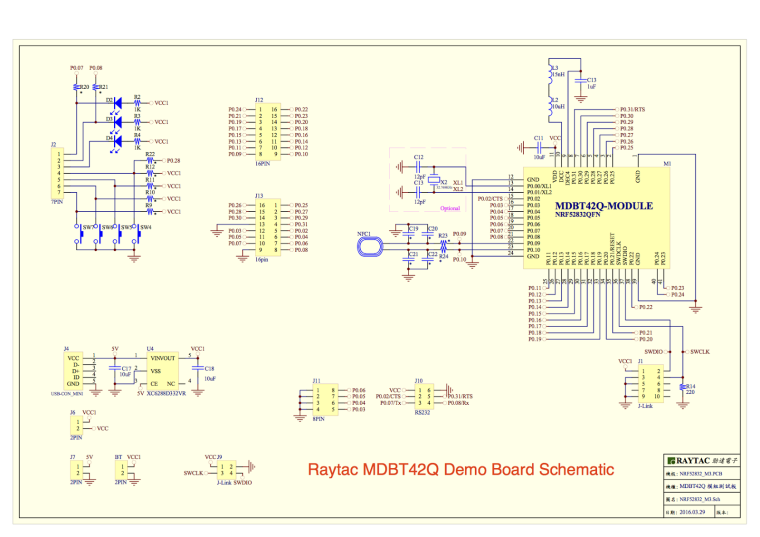
-
@Mike_Lemo said in nRF5 Bluetooth action!:
Oh yeah and forgot to mention I used the generic NRF52 settings.
The "generic" settings haven't a good pin assignment. Pins P0.00 and P0.01 are reserved for the 32KHz crystal and defined as TX/RX pins. That's an conflict.
-
@d00616 said in nRF5 Bluetooth action!:
@Mike_Lemo said in nRF5 Bluetooth action!:
Oh yeah and forgot to mention I used the generic NRF52 settings.
The "generic" settings haven't a good pin assignment. Pins P0.00 and P0.01 are reserved for the 32KHz crystal and defined as TX/RX pins. That's an conflict.
What should we use instead?
-
@NeverDie The "Taida Century nRF52 minidev" has a lot of pins mapped out:
https://github.com/RIOT-OS/RIOT/wiki/Board%3A-nRF52-minidev you can select the programmer like your needs. The RedBear BLE Blend 2 has also a lot of pins mapped out, but the CMSIS-DAP is preselected.
-
@d00616 It says there NFC is not useable but what if my board is NFC hardware ready? how would I use that?
-
@Mike_Lemo said in nRF5 Bluetooth action!:
@d00616 It says there NFC is not useable but what if my board is NFC hardware ready? how would I use that?
It's simple. Use that. NFC isn't enabled or disabled by the board definition. Without SoftDevice, you have to enable the NFC functionality by flashing into the UICR.
You can define your own Board. Look into the "boards.txt" file and the "variants" folder in ~/.arduino15/packages/sandeepmistry/hardware/nRF5/0.3.0/ Most pins can be assigned to roles like SPI, I2C, UART.... Pins like NFC, RESET are fixed and analog Pins an be ordered like your needs.
-
@NeverDie where can that boards.txt file of the NRF52 thing be found?
-
@d00616 I meant is there a library or something for that? how do I approach it I'm relatively new for this 3rd party arduino programming thing and I'ts necessary for me sins I already made a PCB for a micro controller I want to use.
-
@Mike_Lemo said in nRF5 Bluetooth action!:
@NeverDie where can that boards.txt file of the NRF52 thing be found?
On the Windows platform it's located in this directory: Program Files/Arduino/hardware/arduino/avr
-
@NeverDie I can't see the Generic nrf52 board setting
-
I added the two caps that Scalz suggested for DEC1 and DEC2, but I'm still getting the same error message as before when I try to program it using the DK. Unless someone has further ideas, I may have to wait two weeks for my breakout board to arrive before I do more, as right now I'm just deadbugging this by soldering wires directly to the module.
-
@Mike_Lemo said in nRF5 Bluetooth action!:
@NeverDie I can't see the Generic nrf52 board setting
That's all I know, so hopefully someone who knows more can chime in and offer you guidance.
-
BTW, here's a picture of how the silkscreen looks and which shows DEC1 in the "DEC5" location:

-
@NeverDie said in nRF5 Bluetooth action!:
@Mike_Lemo said in nRF5 Bluetooth action!:
@NeverDie I can't see the Generic nrf52 board setting
That's all I know, so hopefully someone who knows more can chime in and offer you guidance.
Oh, I see now that @d00616 already has. Sorry, my browser didn't refresh, so I missed seeing his post.
-
Yeah he did I just preformed a local search for that arduino15 on my PC
-
Also If I want to change the UART pins to other pins would it work without errors or If I want to use 2 or more UARTS? same with I2C
Also what are the debugging options available sins the RS232 is not connected to the MCU like in an arduino how would I set stop points or peek at variables values to see if the code runs as expected?
-
@Mike_Lemo said in nRF5 Bluetooth action!:
you should follow this schematic design if you want to get this module working.

There's a bunch of similar looking schematics in the nRF52832 datasheet for the nRF52832 chip itself, but I'm not sure which of them, if any, is applicable to the Ebyte module. I guess maybe Ebyte needs a demo board schematic like Raytac has. Either that, or we need a schematic of what's on the Ebyte module itself. As it stands, I think maybe there's no enough info with which to move ahead on wiring up the Ebyte module. Am I wrong? Come to think of it, I think some of the other Chinese modules I ordered from Aliexpress may also be similar "mystery" modules.

-
@Mike_Lemo said in nRF5 Bluetooth action!:
Also If I want to change the UART pins to other pins would it work without errors or If I want to use 2 or more UARTS? same with I2C
The Chip has a lot of periphery on it. You can connect most components to pins. There is only one hardware UART, which can be connected. Please look at the Infocenter The arduino-nrf5 port is limited to things are implemented with arduino-samd by the author. This is the reason I have implemented an extension for hwPinMode() in MySensors.
Another fine thing is the implementation of Shortcuts and the PPI. You can do a lot without using the CPU.
@Mike_Lemo said in nRF5 Bluetooth action!:
Also what are the debugging options available sins the RS232 is not connected to the MCU like in an arduino how would I set stop points or peek at variables values to see if the code runs as expected?
Debugging depends on your programmer and flashing tool. I think you can start by search for "openocd gdb". OpenOCD is the flashing tool in arduino-nrf5 for all supported programmers.
-
It looks as though raytec does make two modules for the nRF52832 that has a PCB antenna rather than a chip antenna: the MDBT42Q-P and the MDBT-42V-P:
http://statics3.seeedstudio.com/assets/file/bazaar/product/MDBT42Q-Version_B.pdf
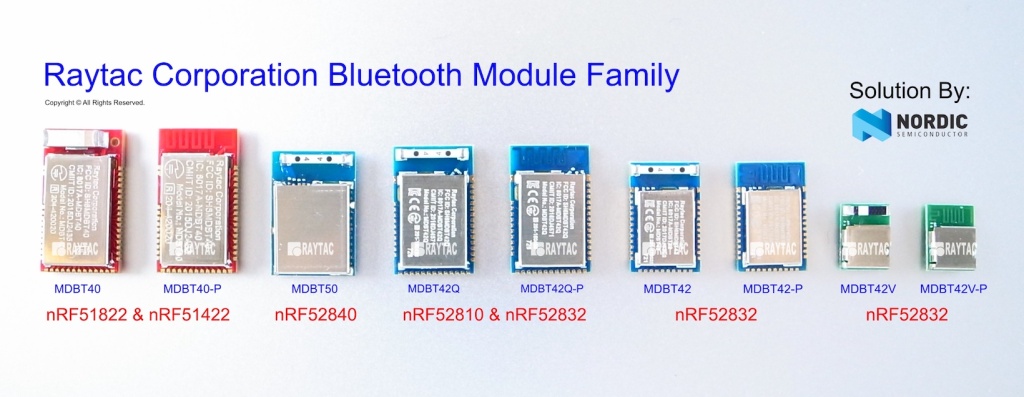
The MDBT-42V-P looks nice because of its small size. Anyone know where it can be purchased? All of a sudden, buying a module that comes with a proper datasheet seems appealing.
-
@NeverDie I had mine from seeed studio
-
@Mike_Lemo said in nRF5 Bluetooth action!:
@NeverDie I had mine from seeed studio
This one? https://www.seeedstudio.com/MDBT42Q-nRF52832-based-BLE-module-p-2736.html
-
I was just now noticing that Nordic has a very convenient list of third party modules (and their dimensions) that use the Nordic nRF52832 chips: https://www.nordicsemi.com/eng/Products/3rd-Party-Bluetooth-low-energy-Modules
-
FWIW, I just now sent an email to support@cdebyte.com requesting either a schematic of their E73-2G4M04S module itself or a schematic for a demo circuit, so that I may be certain about adding the appropriate hardware needed to get their module to work. I'll post if I hear anything back from them.
By the way, in the case of Raytac, they even have their own demo board: https://raytac.blog/2017/01/24/how-to-use-raytac-mdbt42q-nordic-nrf52832-demo-board/
-
I saw this in the MDBT42Q module datasheet, and perhaps it explains the relatively poor performance of the nRF52832 Adafruit Feather which uses the MDBT42Q.:
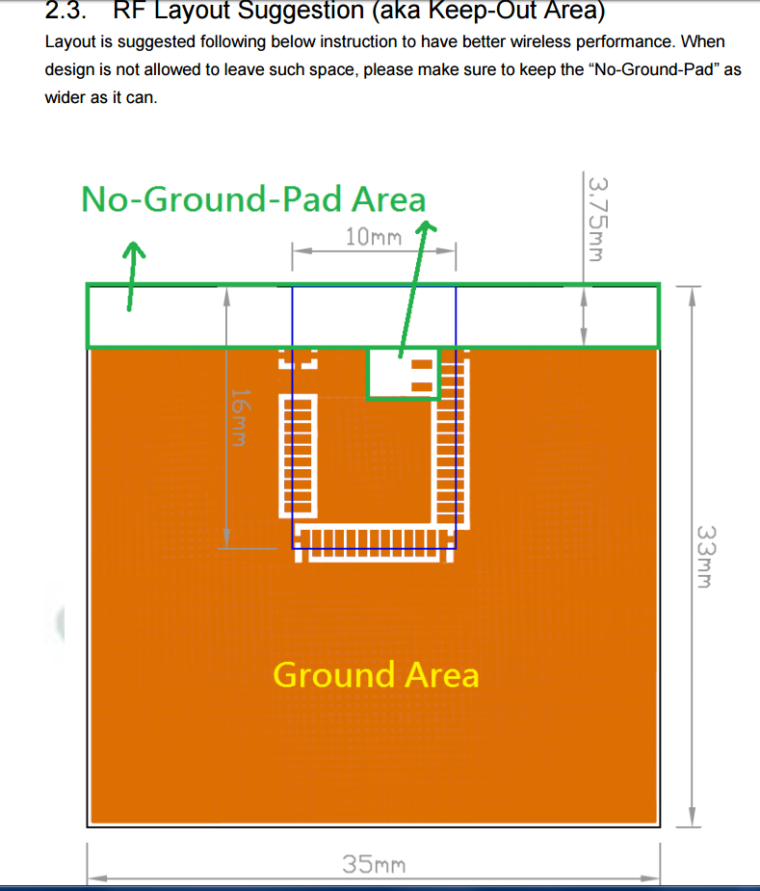
I believe the Adafruit may have a much smaller ground plane than what is being recommended here by Raytac.
-
I requested the schematic for the cdebyte module too...but they replied: it's confidential - LOL.
-
@mtiutiu
How long did it take them to reply to you?I guess we may have to reverse engineer what they did then--at least roughly--in order to use it. I'll see if I can pry the cover off and photograph what's inside. If I'm successful, then I'll post the photos so we can all look at it together.
-
About 6 hours. I asked them too if the Nordic datasheet recommendations were followed or not and if they can provide an example of how to use the module.
-
@mtiutiu said in nRF5 Bluetooth action!:
if they can provide an example of how to use the module
What was their answer to that, or is it still pending? I don't mind them being a black box, provided they show how to use it.
-
@mtiutiu said in nRF5 Bluetooth action!:
I requested the schematic for the cdebyte module too...but they replied: it's confidential - LOL.
this one is funny, like if there was something special in their module

-
@NeverDie
Didn't replied yet. When I get an answer I'll post it here so no worries.
-
Here's a photo with the lid pried off:
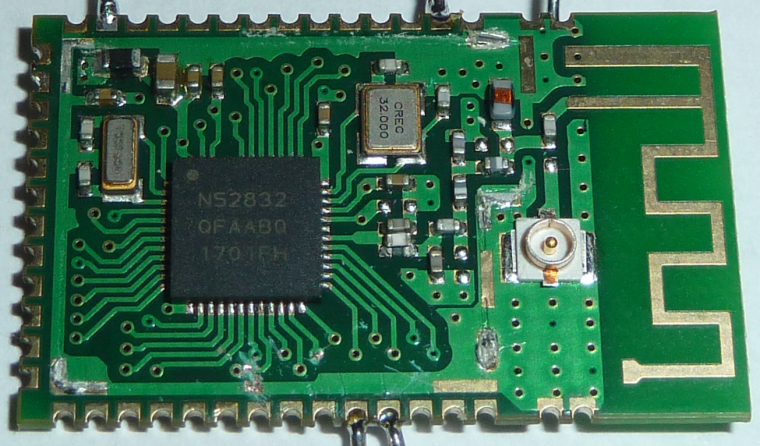
Maybe we can reconstruct what's going on just from looking at the components and the trace lines? At least for now, I'm not so concerned with the RF part.
-
Here's a photo taken from the opposite angle:
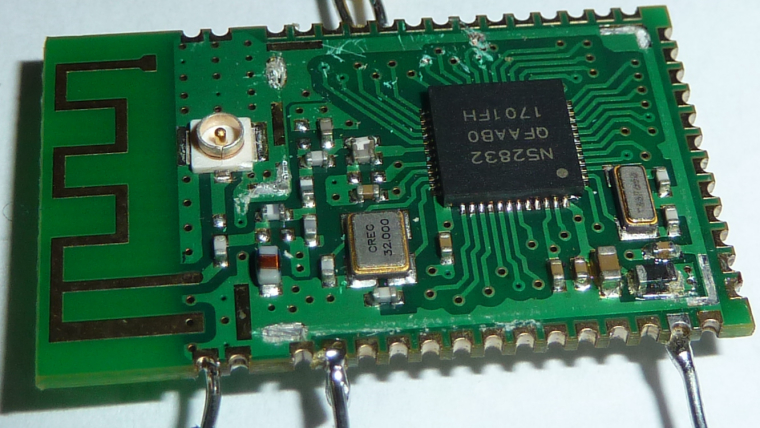
Any other photos anyone wants to see?
-
Here's the back:
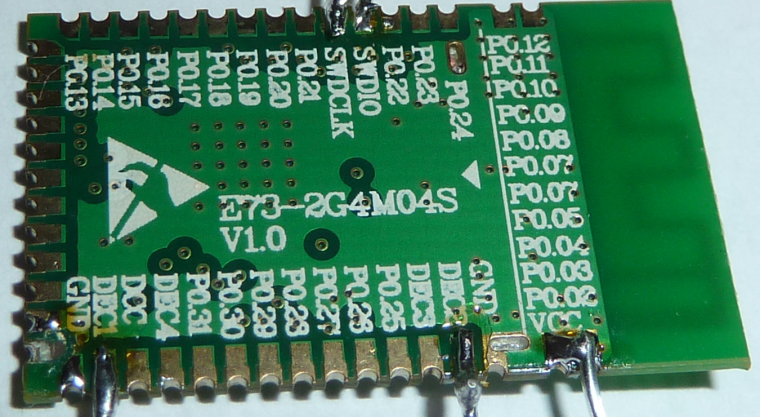
So, is it 4 layer as they claim, or only 2? Some of those vias seem rather pointless if it were only 2 layer.
-
So, to Scalz's earlier point, it looks like indeed there is no capacitor already on DEC1. Regarding DEC2, it appears that there are pads and solder paste for a capacitor, but the capacitor appears to be missing! Manufacturing error?
-
@NeverDie
cool. well you just have to check continuity.
Yes this a 4layers. better for compact RF imho, else worse performance, EMI etc.. I think it's also easier to get FCC with 4layers design (not sure if this module is FCC though)My bad, i've just reread what i wrote. With nrf52 ic, I've rechecked, I'm using:
- DEC1: 100nf
- DEC2: nothing
- DEC3: 100pf
- DEC4: 1uF (and you add inductors with DCC, for DC/DC mode but it can decrease 1dB if i remember well)
-
@scalz
Both DEC3 and DEC4 appear to have capacitors on them. So, maybe it was the missing capacitor on DEC2 that's the reason for the module not seeming to work. I suppose I could crack another one open to see if the missing cap was a fluke or instead likely missing on most/all of them.Obviously, short of removing and testing each smd cap, I can't be sure as to what values eByte is using. I hope it doesn't come to that.... On the other hand, I could possibly remove and test the 3 on scalz's list that are of interest.
-
OK, I just pried off the lid on a different module and.... the same DEC2 cap is missing. However, according to scalz's new list that shouldn't matter.
I'll need to check continuity to see if the DEC1 cap is really not there or rather simply appearing elsewhere due to the routing.
-
It turns out DEC1 is connected to a capacitor: it's the one just south of the top left capacitor in the first photo.
So, unless the cap values are just wrong, it seems that we don't need to add any more.
-
What should I check next?
-
@NeverDie I just made the antenna on my PCB stick out so there is no fiber glass under the antenna even.
Also what is a good library for using NFC and the bluetooth peripheral of that MCU?
I came across that library:https://github.com/sandeepmistry/arduino-BLEPeripheral
but the page doesn't seem to support the BLE capability of the NRF52832
and no luck for the NFC
-
@d00616 said in nRF5 Bluetooth action!:
@Mike_Lemo said in nRF5 Bluetooth action!:
Also If I want to change the UART pins to other pins would it work without errors or If I want to use 2 or more UARTS? same with I2C
The Chip has a lot of periphery on it. You can connect most components to pins. There is only one hardware UART, which can be connected. Please look at the Infocenter The arduino-nrf5 port is limited to things are implemented with arduino-samd by the author. This is the reason I have implemented an extension for hwPinMode() in MySensors.
Another fine thing is the implementation of Shortcuts and the PPI. You can do a lot without using the CPU.
@Mike_Lemo said in nRF5 Bluetooth action!:
Also what are the debugging options available sins the RS232 is not connected to the MCU like in an arduino how would I set stop points or peek at variables values to see if the code runs as expected?
Debugging depends on your programmer and flashing tool. I think you can start by search for "openocd gdb". OpenOCD is the flashing tool in arduino-nrf5 for all supported programmers.
What is that MySensors thing you were talking about?
-
@Mike_Lemo said in nRF5 Bluetooth action!:
I just made the antenna on my PCB stick out so there is no fiber glass under the antenna even.
Yeah, that's what I opted for on Version 2 of my breakout board for the Ebyte nRF52832 module. Seems like the cleanest solution.
The MDBT42Q is a lot smaller than the Ebyte module, so although I was bashing it for its performance on the Adafruit (which in their case may turn out to be ground plane related), that might be an acceptable trade-off for the smaller size.
You have lots of good questions. Keep asking! I'm hoping to learn from the answers too.
-
OK, here's my plan:
-
It's possible the connections on my first attempt were a bit dodgy. I'll try again, but this time soldering a fresh new module to a prototype PCB so that they won't be mechanically stressed as I interconnect wires. Not as ideal as my breakout board will be, but I'll have to make do until it arrives.
-
If it still fails to program after step #1, then I'll check to confirm whether or not the oscillators are, uh, oscillating, at the proper frequency by using an oscilliscope after powering it up. I'm assuming they are, but it's at least easy to check and then cross off the list of suspects.
-
If still no clues, then what's next? Logic probe on the two SW lines for a compare/contrast against a successful programming of a sparkfun nRF52832 board? That's sure to generate at least some palpable data as to where the problem is occurring.
I welcome other suggestions though on how to proceed. The above is just my best guess, and I'm sure others here are better at troubleshooting this than I am.
-
-
@NeverDie said in nRF5 Bluetooth action!:
@Mike_Lemo said in nRF5 Bluetooth action!:
I just made the antenna on my PCB stick out so there is no fiber glass under the antenna even.
Yeah, that's what I opted for on Version 2 of my breakout board for the Ebyte nRF52832 module. Seems like the cleanest solution.
The MDBT42Q is a lot smaller than the Ebyte module, so although I was bashing it for its performance on the Adafruit (which in their case may turn out to be ground plane related), that might be an acceptable trade-off for the smaller size.
You have lots of good questions. Keep asking! I'm hoping to learn from the answers too.
Yeah well at least I managed to flash a blink program to my pcb and confirm that it works but now I'm planning to abanded from Arduino anyways sins alot of functionality isn't supported.
-
@Mike_Lemo said in nRF5 Bluetooth action!:
sins alot of functionality isn't supported
If your abandoning from Arduino, what will you be abandoning to?
-
@NeverDie said in nRF5 Bluetooth action!:
@Mike_Lemo said in nRF5 Bluetooth action!:
sins alot of functionality isn't supported
If your abandoning from Arduino, what will you be abandoning to?
Probably eclipse
-
@Mike_Lemo said in nRF5 Bluetooth action!:
@NeverDie said in nRF5 Bluetooth action!:
@Mike_Lemo said in nRF5 Bluetooth action!:
sins alot of functionality isn't supported
If your abandoning from Arduino, what will you be abandoning to?
Probably eclipse
I'm rather hazy on the differences. I guess that way you can use all the Nordic libraries the way they were intended?
-
Eclipse is just an IDE
 like Arduino IDE, or VS etc.
like Arduino IDE, or VS etc.
I think he means he wants to leave arduino core (mysensors rely on arduino core) to use nordic sdk with other ide (like eclipse, mbed, keil etc..). Because using eclipse with arduino core won't unlock features. It still needs coding.
-
@scalz arduino.org ble library that's based on sandeepmistry's one seems very extensive.
I believe one need pretty substantial reasons to migrate from arduino unless you are a professional developer
-
Bluetooth is everywhere, and that's great, but I'm developing the impression that Bluetooth is rather arduous to program in its "native" format. Maybe this is an opportunity to build something simpler/easier that runs on top of Bluetooth, and yet can still interact with normal bluetooth devices in the native bluetooth that they understand? I think the Arduino's wide acceptance more or less proves that "easy is good."
-
@NeverDie fully agree
-
@NeverDie said in nRF5 Bluetooth action!:
OK, here's my plan:
-
It's possible the connections on my first attempt were a bit dodgy. I'll try again, but this time soldering a fresh new module to a prototype PCB so that they won't be mechanically stressed as I interconnect wires. Not as ideal as my breakout board will be, but I'll have to make do until it arrives.
-
If it still fails to program after step #1, then I'll check to confirm whether or not the oscillators are, uh, oscillating, at the proper frequency by using an oscilliscope after powering it up. I'm assuming they are, but it's at least easy to check and then cross off the list of suspects.
-
If still no clues, then what's next? Logic probe on the two SW lines for a compare/contrast against a successful programming of a sparkfun nRF52832 board? That's sure to generate at least some palpable data as to where the problem is occurring.
I welcome other suggestions though on how to proceed. The above is just my best guess, and I'm sure others here are better at troubleshooting this than I am.
I executed step #1 of my plan with no change in results on the second attempt of programming. The module is definitely getting 3.3v power on the VCC pin.
So, I executed step #2. I don't see any oscillation at all on the 32.7khz oscillator. The faster oscillator is mostly quiet, but it periodically gives short little bursts of activity--here's a screenshot of one:

Not sure if this is normal or not, but that's what is going on.
-
-
@Toyman what is that libray? I think of you refer to bel peripheral v0.3 it might not support the nrf52832 as I was asking before.
-
So, for comparison, I measured the Sparkfun nRF52832 board, because (unlike the adafruit with its Raytac module), both oscillators are exposed for measurement. Unfortunately, it is already programmed, so it is not a true apples-to-apples comparison, but, anyway, the measurements were definitely different. First of all, the 32.7Khz oscillator was continuously oscillating at around 32.9Khz:
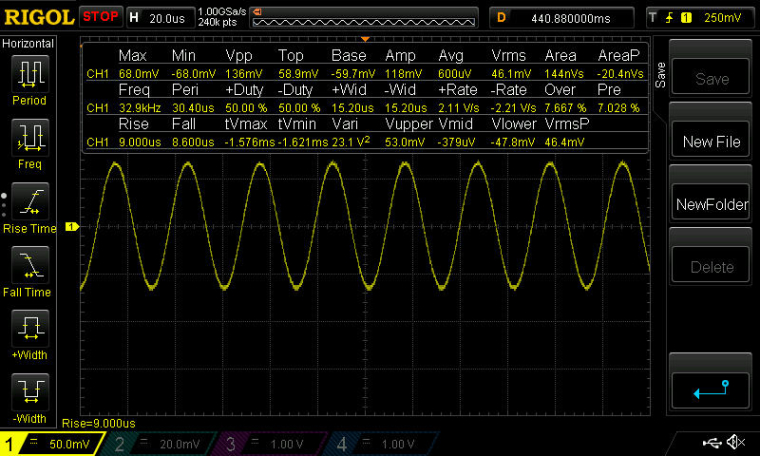
and the faster oscillator was also continuously oscillating:
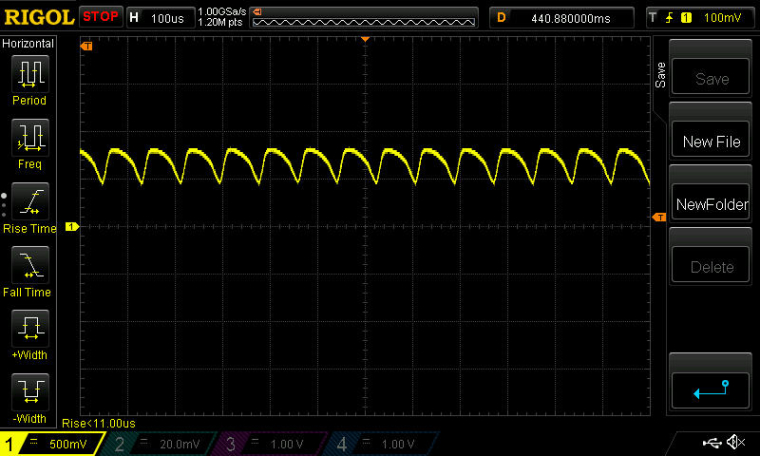
I guess to have an apples-to-apples I would have to completely erase the firmware on the Sparkfun board.Anyhow, I think I'm getting the urge to order some Raytac modules.... It sounds as though they are not such a mystery.
-
One thing I notice on the Ebyte module is that no RESET pin is exposed. Isn't that a bit odd?
Also, there appears to be a typo on the silkscreen, where there are two pin 7's on the silkscreen, but probably one of them is actually pin 6.
-
By the way, those short bursts on activity on the Ebyte module's fast oscillator happen pretty regularly, about every 22ms or so:
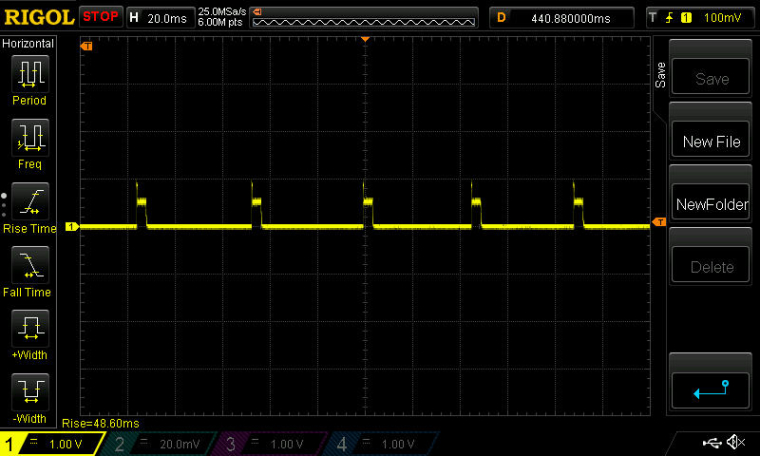
-
@NeverDie how many GND pins did you connect ?
It might be a stupid suggestion but maybe all GND pins are not connected together ?
-
http://www.arduino.org/learning/reference/ble
This is their "homework" in anticipation of Primo launch. It does support nrf52
-
Ok, so after posting some questions to CDSENET Aliexpress store(in regards to the E73-2G4M04S module):
1. Is the nrf52832 IC DEC1 pin decoupled with a 100nF capacitor as per Nordic datasheet recommendations? 2. Is the nrf52832 IC DEC2 pin decoupled with a 100pF capacitor as per Nordic datasheet recommendations? 3. Are all the power pins of the nrf52832 IC decoupled as per Nordic datasheet recommendations? 4. Are the external components already provided so that the internal DC-DC converter can be used?I received this part of schematic:
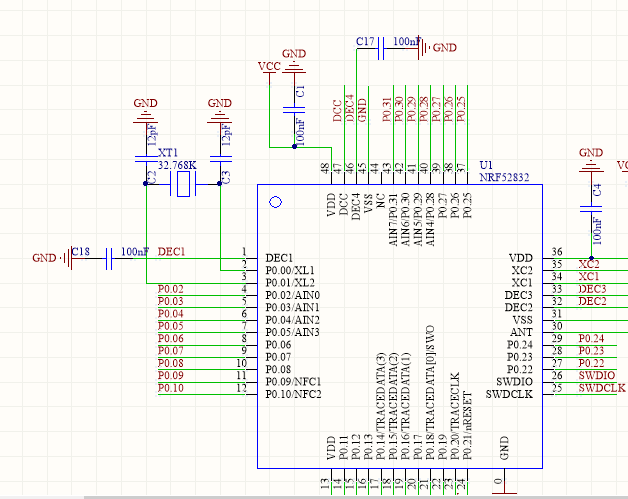
The module that I bought is this one: CDSENET E73-2G4M04S
I hope that it helps demystify some things in regards to this module. Maybe @NeverDie can confirm this by checking his module connections as seen in the above schematic. I'm saying this because Chinese support is well..not so user friendly in my experience and I don't know if the above schematic is indeed what they used on their module or they just provided me an example schematic of how to use the NRF52832 IC in general instead.
-
@Mike_Lemo @Toyman
BLEPeripheral lib from sandeep is working fine with nrf52832, as i'm using it
Regarding the sch above, it looks like a classic circuit (in LDO mode, not surprising as DCDC mode is optional). I'm not using same values but this should work..
-
They sent me two files, but I have no idea what they are, or how to open them. Maybe someone here recognizes them or can open them?
0_1500890784640_E73-2G4M04S-PCBLIB.PCBLIB
0_1500890793687_E73-2G4M04S-PCB-V1.0.PCBDOCPreview
-
@scalz said in nRF5 Bluetooth action!:
Regarding the sch above, it looks like a classic circuit (in LDO mode, not surprising as DCDC mode is optional). I'm not using same values but this should work..
From what little I've read in the nRF52832 datasheet (and please do correct me if I'm wrong), the LDO mode is the "default", and is not as power efficient as the DCDC mode. Not good, as most of us probably want this for battery operation. Therefore, even if it were to work in LDO mode, what we should probably want is the DCDC mode. So, are we screwed? Or, can DCDC mode be easily applied on top of whatever they've already hardwired in the module by just adding a few more components?
-
@Toyman said in nRF5 Bluetooth action!:
http://www.arduino.org/learning/reference/ble
This is their "homework" in anticipation of Primo launch. It does support nrf52
@scalz said in nRF5 Bluetooth action!:
@Mike_Lemo @Toyman
BLEPeripheral lib from sandeep is working fine with nrf52832, as i'm using it
Regarding the sch above, it looks like a classic circuit (in LDO mode, not surprising as DCDC mode is optional). I'm not using same values but this should work..
If you say so that's great I've downloaded that BLEPeripheral library opened one of the test and led examples and there are a few things I don't understand why would I have to define those IRQ pins and include SPI library to use the BLE on board?
If order to send data back and forth between peripheral and central you have to use this function:?
to read: switchCharacteristic.value();
to write:characteristic.setValue(value, length);do you maybe have a little simple example to establish a connecting between central and peripheral with sending random data and peripheral and a smartphone?
-
For DC-DC converter you need to add some external inductor(s) and some capacitor to the DCC pin if I remember correctly. This can be observed here:
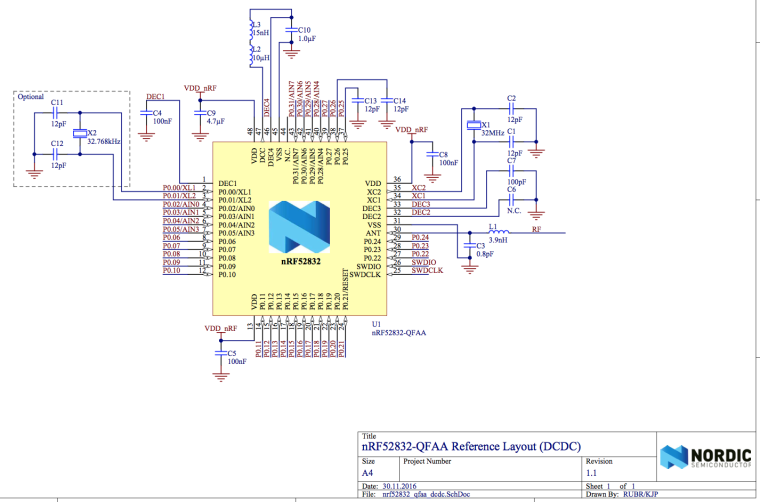
And more than that it needs to be enabled from the SDK also.
I didn't read the official datasheet and the recommendations from it yet...so I don't know all the implications.
From what I've read so far this needs to be added before anything else(I think a good place is the
beforehook from MySensors):void before() { NRF_POWER->DCDCEN = 1; }And maybe this will shed some light too: https://devzone.nordicsemi.com/question/69091/a-question-about-nrf52832s-dcdc-and-ldo/
-
@mtiutiu there is a little confusion
 this is the reference sch for nrf51. It is a bit different for nrf52.
this is the reference sch for nrf51. It is a bit different for nrf52.@Mike_Lemo no you dont need to set these pins which could be removed from the init function.
Yes these functions are used for ble comm.
I think sharing my unfinished code is useless (arduino & phone) if you have troubles with arduino examples. I have no time for an howto actually and little bit out of mysensors scope imho .The arduino examples are working fine.
There are already written howtos at sparkfun, adafruit, blogs etc
If you need more infos, maybe you can get more help on arduino forum too..
And for general understanding of ble and its mechanisms (providers, services, characteristics..), you can take a look at bluetooth sig.
Finally for custom phone app, you have to code with your preferred techno or use nordics app for simple debug
-
My bad. I corrected the initial post. Hope is all well now.
I'm going to try this one too when I have time wt51822-s4at
This is the cheapest of all that I found so far and yes it's not a nrf52832 but a nrf51822 - for my purpose this one is very good too. It doesn't have all the pins exposed - only 7 of them but again it should fit my general usage. I'm curious about its performance though. I'll see that when I get my hands on it. This is the official datasheet(or so it seems): https://4tronix.co.uk/picobot2/WT51822-S4AT.pdf
-
@NeverDie said in nRF5 Bluetooth action!:
They sent me two files, but I have no idea what they are, or how to open them. Maybe someone here recognizes them or can open them?
0_1500890784640_E73-2G4M04S-PCBLIB.PCBLIB
0_1500890793687_E73-2G4M04S-PCB-V1.0.PCBDOCPreviewOpening the first file in notepad, I notice that it says, "PCB 6.0 Binary Library File ". I had asked Ebyte for either the module schematic or a reference design using their part, so I'm guessing this is it, in some sort of PCB CAD file.
-
I think they use Altium Designer and that those are files generated with it.
-
@mtiutiu if so, the free viewer is available at their site
-
@mtiutiu I have ordered a few of those modules too, the big question is antenna performance as it seems rather small.
It's incredibly cheap and has enough pins to drive most of the MySensors nodes, too bad it's missing the 32K crystal for low power Bluetooth
-
I think that if we use a serial gw based on nrf24l01 pa lna variant should help cover a regular house. At least this is my intent but until then I need to prepare some test environment. And if using nrf5 repeater nodes also should help with coverage - this doesn't work for battery powered nodes I know. But I think there should be some nrf5 nodes that are powered permanently - like actuators for example.
-
Can you upload those files somewhere so that I can download them? I can't do that from the links you pasted here in this forum.
I also found this altium -> kicad online converter but I don't know how well it works.
-
@mtiutiu said in nRF5 Bluetooth action!:
Can you upload those files somewhere so that I can download them? I can't do that from the links you pasted here in this forum.
-
Doesn't work for me so maybe it would be best to obtain a pdf or something readable for all of us from the manufacturer.
-
Is no one else able to download the files either?
-
@Nca78 said in nRF5 Bluetooth action!:
@NeverDie how many GND pins did you connect ?
It might be a stupid suggestion but maybe all GND pins are not connected together ?Good question. I connected to just one GND pin. However, I just now checked with a DMM, and all the exposed GND pins on the module have continuity to one another. So, based on that, I'm assuming any additional outside connections would be redundant anyway?
-
@NeverDie said in nRF5 Bluetooth action!:
Is no one else able to download the files either?
From the forum, no. From hightail, yes.
I don't know which program to open them in though.
-
@mfalkvidd said in nRF5 Bluetooth action!:
I don't know which program to open them in though
The current theory (see above) is that maybe it's Altium Designer, which has a free viewer.
-
@NeverDie said in nRF5 Bluetooth action!:
One thing I notice on the Ebyte module is that no RESET pin is exposed. Isn't that a bit odd?
Correction: According to the Nordic datasheet, PO.21, which is exposed on the Ebyte modle, can also serve as the reset pin. I was thrown off because Sparkfun labeled it RESET on their board's silkscreen, not "PO.21".
-
@Nca78 said in nRF5 Bluetooth action!:
I have ordered a few of those modules too,
Do let us know if either of you are able to program it. After this Ebyte experience, I won't be taking it for granted anymore.
-
@NeverDie not sure if it applies to this case, but at 18:04 in https://youtu.be/JXQLI-nXqmQ it is mentioned that the chip's identifier needs to be included in some list when the softdevice is compiled (or something along those lines, I am not yet familiar with the vocabulary).
-
@mfalkvidd said in nRF5 Bluetooth action!:
@NeverDie not sure if it applies to this case, but at 18:04 in https://youtu.be/JXQLI-nXqmQ it is mentioned that the chip's identifier needs to be included in some list when the softdevice is compiled (or something along those lines, I am not yet familiar with the vocabulary).
My understanding (which may be wrong) is that in this context a "softdevice" is a veiled reference to the bluetooth stack and/or related bluetooth code, which at present the mysensors code isn't using. In any case, when I programmed both the adafruit and the sparkfun using the mysensors code, I didn't include a chip identifier in a list, nor any soft devices, and it worked anyway.
-
I was thinking that maybe the Ebyte module is stuck in some kind of reset mode, but I just now checked pin P0.21 (the reset pin), and it measures high at 3.3v. This is the same as for the Sparkfun board, which I have no trouble programming. Reset is active low.
-
@NeverDie said in nRF5 Bluetooth action!:
My understanding (which may be wrong) is that in this context a "softdevice" is a veiled reference to the bluetooth stack and/or related bluetooth code, which at present the mysensors code isn't using. In any case, when I programmed both the adafruit and the sparkfun using the mysensors code, I didn't include a chip identifier in a list, nor any soft devices, and it worked anyway.
I haven't tested MySensors with a present SoftDevice. The drivers/NVM code (EEPROM emulation) conflicts with the DFU bootloader.
It's better to see the SoftDevice as an Operating System providing BLE functionality and some hardware abstraction, while MySensors is directly ported to the hardware.
-
@NeverDie stupid question: did you try to power it NOT from DK board and vise versa?
-
@Toyman said in nRF5 Bluetooth action!:
@NeverDie stupid question: did you try to power it NOT from DK board and vise versa?
Thanks for the suggestion! So far I've tried powering it from a USB 3.3v source (which is how I successfully programmed the adafruit and sparkfun boards), but I'll now try powering it from the DK and see if it makes a difference.
By the way, I found an alternate way to confirm that the board is using the built-in LDO rather than the DCDC converter. DEC4 is the output of the LDO, and it measures 1.3v (which is also the expected voltage output by the LDO if it were active). DCC is the output of the DCDC converter, and it measures 0.0v. So, empirical confirmation of what you all inferred earlier.

-
@Toyman said in nRF5 Bluetooth action!:
@NeverDie stupid question: did you try to power it NOT from DK board and vise versa?
Just now tried it, and unfortunately it didn't make a difference.

The actual text of the error message that I always receive is:
c:/users/david/appdata/local/arduino15/packages/sandeepmistry/tools/gcc-arm-none-eabi/5_2-2015q4/bin/../lib/gcc/arm-none-eabi/5.2.1/../../../../arm-none-eabi/bin/ld.exe: warning: changing start of section .heap by 4 bytes
c:/users/david/appdata/local/arduino15/packages/sandeepmistry/tools/gcc-arm-none-eabi/5_2-2015q4/bin/../lib/gcc/arm-none-eabi/5.2.1/../../../../arm-none-eabi/bin/ld.exe: warning: changing start of section .stack_dummy by 4 bytes
c:/users/david/appdata/local/arduino15/packages/sandeepmistry/tools/gcc-arm-none-eabi/5_2-2015q4/bin/../lib/gcc/arm-none-eabi/5.2.1/../../../../arm-none-eabi/bin/ld.exe: warning: changing start of section .heap by 4 bytes
c:/users/david/appdata/local/arduino15/packages/sandeepmistry/tools/gcc-arm-none-eabi/5_2-2015q4/bin/../lib/gcc/arm-none-eabi/5.2.1/../../../../arm-none-eabi/bin/ld.exe: warning: changing start of section .stack_dummy by 4 bytes
c:/users/david/appdata/local/arduino15/packages/sandeepmistry/tools/gcc-arm-none-eabi/5_2-2015q4/bin/../lib/gcc/arm-none-eabi/5.2.1/../../../../arm-none-eabi/bin/ld.exe: warning: changing start of section .heap by 4 bytes
c:/users/david/appdata/local/arduino15/packages/sandeepmistry/tools/gcc-arm-none-eabi/5_2-2015q4/bin/../lib/gcc/arm-none-eabi/5.2.1/../../../../arm-none-eabi/bin/ld.exe: warning: changing start of section .stack_dummy by 4 bytes
Sketch uses 26932 bytes (5%) of program storage space. Maximum is 524288 bytes.
Open On-Chip Debugger 0.10.0-dev-00254-g696fc0a (2016-04-10-10:13)
Licensed under GNU GPL v2
For bug reports, read
http://openocd.org/doc/doxygen/bugs.html
debug_level: 0
swd
adapter speed: 10000 kHz
cortex_m reset_config sysresetreq
nrf52.cpu: target state: halted
target halted due to debug-request, current mode: Thread
xPSR: 0x01000000 pc: 0x000008e4 msp: 0x20000400
** Programming Started **
auto erase enabled
Error: Cannot erase protected sector at 0x0
Error: failed erasing sectors 0 to 6
embedded:startup.tcl:454: Error: ** Programming Failed **
in procedure 'program'
in procedure 'program_error' called at file "embedded:startup.tcl", line 510
at file "embedded:startup.tcl", line 454
the selected serial port at file "embedded:startup.tcl", line 454
does not exist or your board is not connectedSo maybe the root of the problem is that I need to do something to enable it to erase the protected sector at 0x0? That seems to be the point after which everything falls apart.
-
@NeverDie sorry, the ID doesn't need to be in the softdevice. It needs to be in the code for the black magic probe. Might still not be related though.
-
@NeverDie said in nRF5 Bluetooth action!:
Error: Cannot erase protected sector at 0x0
Could this be related to the readback protection? The video I linked before recommends issuing "monitor erase_mass" to completely reset the device and any protection.
-
@mfalkvidd said in nRF5 Bluetooth action!:
@NeverDie said in nRF5 Bluetooth action!:
Error: Cannot erase protected sector at 0x0
Could this be related to the readback protection? The video I linked before recommends issuing "monitor erase_mass" to completely reset the device and any protection.
Good one! I have a hunch you may have just cracked the problem.
I see no harm in trying a mass erase before the programming step, so I'll give it a go.
